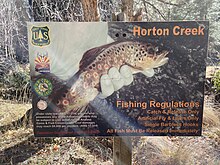
The goal of fisheries management is to produce sustainable biological, environmental and socioeconomic benefits from renewable aquatic resources. Wild fisheries are classified as renewable when the organisms of interest (e.g., fish, shellfish, amphibians, reptiles and marine mammals) produce an annual biological surplus that with judicious management can be harvested without reducing future productivity.[1] Fishery management employs activities that protect fishery resources so sustainable exploitation is possible, drawing on fisheries science and possibly including the precautionary principle.
Modern fisheries management is often referred to as a governmental system of appropriate environmental management rules based on defined objectives and a mix of management means to implement the rules, which are put in place by a system of monitoring control and surveillance. An ecosystem approach to fisheries management has started to become a more relevant and practical way to manage fisheries.[2][3] According to the Food and Agriculture Organization of the United Nations (FAO), there are "no clear and generally accepted definitions of fisheries management".[4] However, the working definition used by the FAO and much cited elsewhere is:
The integrated process of information gathering, analysis, planning, consultation, decision-making, allocation of resources and formulation and implementation, with necessary law enforcement to ensure environmental compliance, of regulations or rules which govern fisheries activities in order to ensure the continued productivity of the resources and the accomplishment of other fisheries objectives.[4]
- ^ Lackey, Robert; Nielsen, Larry, eds. (1980). Fisheries management. Blackwell. p. 422. ISBN 978-0632006151.
- ^ "The ecosystem approach to fisheries" (PDF). FAO. Retrieved 7 July 2023.
- ^ Garcia SM, Zerbi A, Aliaume C, Do Chi T, Lasserre G (2003). The ecosystem approach to fisheries. Issues, terminology, principles, institutional foundations, implementation and outlook. FAO. ISBN 9789251049600.
- ^ a b FAO (1997) Fisheries Management Section 1.2, Technical Guidelines for Responsible Fisheries. FAO, Rome. ISBN 92-5-103962-3